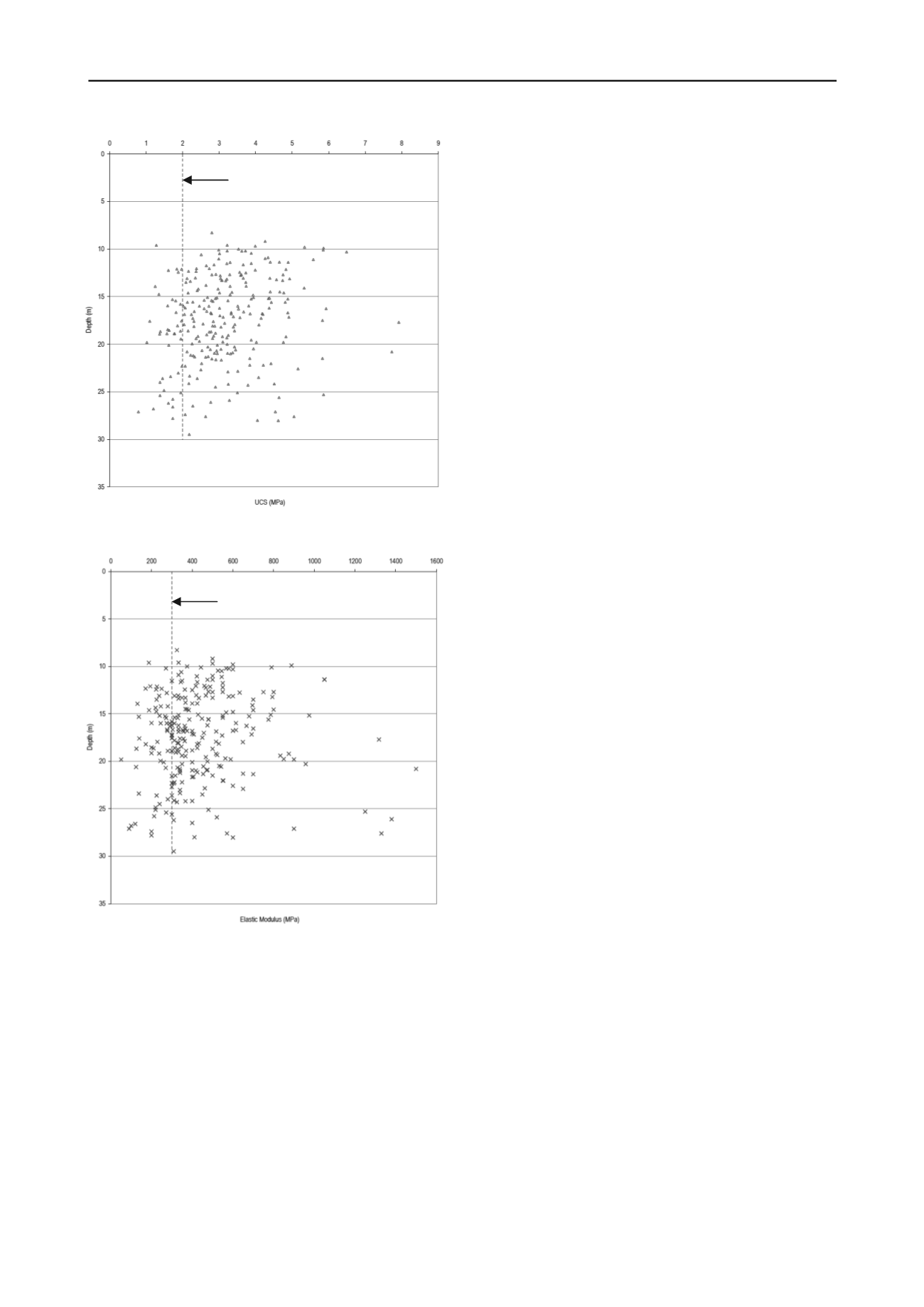
1258
Proceedings of the 18
th
International Conference on Soil Mechanics and Geotechnical Engineering, Paris 2013
Figure 6. Measured uniaxial compressive strengths of the jet grouted
materials.
Figure 7. Measured Young’s modulus of the jet grouted materials.
The UCS and Young’s modulus measured from the core
samples of the working jet grout columns are plotted in Figures
7 and 8. It can be observed that the mean values of UCS and
Young’s modulus are well above the assumed design values.
For the cases where the measured UCS or Young’s modulus of
a particular jet grout column was below the design value, a
design review was carried out. The design review assessed the
likely behaviour of the excavation using finite element
technqiues assuming that the strength or stiffness of the jet
grout columns was reduced to the measured value. If the design
criteria set out in Section 2.3 could still be met, the revised
design was considered acceptable. On the contrary, additional
jet grout columns were constructed to ensure that the excavation
is of suffcient safety margin.
The purpose of coring and testing conducted on the core
samples of the working jet grout columns was to verify the
design assumptions made in the design analyses. It is important
to monitor the actual performance of the construction through
field instrumentation. A comprehesive instrucmentation plan
has been adopted for such purposes. Inclinometers have been
installed in the diaphragm wall as well as in some of the jet
grout columns. The measured deflection is used to closely
monitor the actual performance of the construction using the
predictions made by finite element analyses as a reference.
Design value
4 CONCLUSIONS
The use of soil berm to support deep excavation is not
uncommon and has been used for decades. However most of the
previous cases involved excavation in stiff clay. The stability of
the soil berm is therefore not a concern – at least for short term
conditions.
This paper describes a case where bermed excavation is
adopted in a geologically complex site. The overall stability is
adversely affected by the presence of soft marine clay. Without
ground treament, finite element analyses predicted a potental
failure mechanism initiated from sliding along the base of the
marine clay layer. In order to enhance the overal stability, jet
grouting as a ground treatment method was introduced. Finite
element analyses also showed that the jet grout columns could
avoid the formation of a global sliding failure along the marine
clay layer if sufficent strength of the jet grouted material can be
mobilised at small deformation. Verification of the design
parameters was done through a site trial which consisted of
labortoary and in-situ tests. Quality control and verification of
the acutal performance were achieved by obtaining core
samples from the working jet grout columns together with a
comprehensive monitoring scheme.
Design value
5 ACKNOWLEDGEMENTS
The permission to publish this paper by the Mass Transit
Railway (MTR) Corporation Limited is gratefully
acknowledged.
6 REFERENCES
Daly, M. P. and Powrie, W. 2001. Undrained analysis of earth berms as
temporary supports for embedded retaining walls.
Proceedings of
the Institution of Civil Engineers, Geotechnical Engineering
, 149
(4), 237-248.
Geotechnical Engineering Office (GEO) 1988.
Guide to Rock and Soil
Descriptions
, Geoguide 3, Hong Kong Government.
Peck, R.B. 1969. Deep excavations and tunneling in soft ground. State-
of-the-art Report,
7th International Conference on Soil Mechanics
& Foundation Engineering
, Mexico City, State-of-the-art Volume,
225-290.
Powrie, W. & Daly, M.P. 2002. Centrifuge model tests on embedded
retaining walls supported by earth berms.
Géotechnique
52 (2), 89-
106.
Simpson B. and Powrie. W. 2001. Embedded retaining walls: theory,
practice and understanding. Proceedings of the 15th International
Conference on Soil Mechanics and Geotechnical Engineering,
Istanbul.


